| |
HCV Elimination Model Forecast Reduced Prevalence to 0.3% by Improving Harm Reduction, HCV Testing & Treatment, Removing Restrictions - Mandated Universal Screening Needed
|
| |
| |
Download the PDF here
HCV Elimination: Universal Routine Screening Should be Mandated -
in light of the White House announcement that viral hepatitis would be eliminated by 2030
Our Nation has set a goal to eliminate viral hepatitis by 2030.", Pres. Biden - (05/19/21) - plus this recent CDC announcement
New CDC Update - Acute HCV Increased 14% from 2018 to 2019 - (05/19/21) - therefore, nationwide universal routine screening should be implemented & mandated for all conducted by our labs who provide our routine blood labs testing
Acute HCV infection persists in increasing annually - see tables. graphs below for CDC data on increasing acute HCV - The number of cases reported during 2019 corresponded to a 14% increase from the 3,621 cases reported during 2018, and a 133% increase from the 1,778 cases reported during 2019. - an estimated 57,500 new cases of acute HCV reported after adjustments, see below - and Chronic HCV infection persists at high levels despite some decline likely due to the recent treatments with DAAs that cure HCV at high rates of 95% - A total of 123,312 new chronic hepatitis C cases were reported during 2019.. Yet, HCV is curable with short term 8-12 weeks tolerable & safe treatment of daily pills with 95% cure rates in many studies. Treatment is a one-time cost as low as $15000 per regimen. We can't cure HIV, diabetes, cancers, or heart disease, which if we could do you think would not be made available to all. It's quite an example of healthcare disparity & discrimination as HCV affects the most vulnerable people and death rates reported by the CDC - see graph, table below - remain high despite highly effective treatment due to late or no testing & diagnoses with HCV, & late treatment. The CDC estimates $400 million a year for a time limited period which could be 6 years would eliminate HCV in the USA, that is only $3 billion, a relatively small amount to the federal government, yet Congress has only allocated $39 million a year without any significant increases persistently. The quiet non-responsive is deafening; the White House issued a statement May 19 2021 for the first time announcing viral hepatitis would be eliminated by 2030 but we have not heard a word since. HHS has a large-scale strategy outlined waiting for funding for several years.
New study just published (JAMA Netw Open. Aug. 2021) - We developed a dynamic model to evaluate interventions aimed at specific failures in the HCV care cascade for PWID, ie, insufficient testing, low treatment uptake, and inadequate access to harm reduction, and forecasted HCV outcomes associated with these interventions in New Hampshire. Our results suggest that improvements in both testing and treatment are required to achieve the WHO goal of reducing HCV incidence by 80% among PWID in New Hampshire by 2030. Bottlenecks in the HCV care cascade often originate from state-level policies on Medicaid reimbursement and HCV surveillance efforts. Examples of interventions to increase testing and treatment uptake include conducting screening and treatment in prisons; community integration of HCV education, workup, and treatment; and removing Medicaid restrictions on sobriety, prescriber, and fibrosis criteria.11,13,15,39 The lack of good state-level data on PWID poses a challenge for policy makers seeking to identify and address weaknesses in their HCV care cascade; resources like the Hepatitis C Medicaid Affinity Group can help states share best practices.
Results A total of 6 scenarios were tested: (1) the base case, (2) improved harm reduction, (3) improved testing, (4) improved treatment, (5) improved testing and treatment, and (6) improved testing, treatment, and harm reduction. All scenarios with improved testing, treatment uptake, and/or access to harm reduction were associated with decreases in forecasted HCV prevalence and HCV-associated mortality compared with the base case.
........Improving harm reduction, testing, and treatment individually were forecast to reduce prevalence of HCV in 2045 from 69.7% in the base case to 62.8%, 45.7%, and 35.5%, respectively.
........Combining treatment and testing improvements was associated with a 2045 prevalence of 0.3%; adding harm reduction improvements was associated with further reductions in prevalence forecasts (to 0.2%), with fewer total treatments (10 960 vs 13 219 from 2022-2045).
Conclusions and Relevance - In this modeling study, no single intervention was projected to achieve World Health Organization HCV elimination targets. Scenarios with improvements in both testing and treatment were associated with a prevalence of less than 3% by 2030 and achieved elimination targets. Adding improvements in harm reduction was associated with faster reductions in prevalence and fewer treatments.
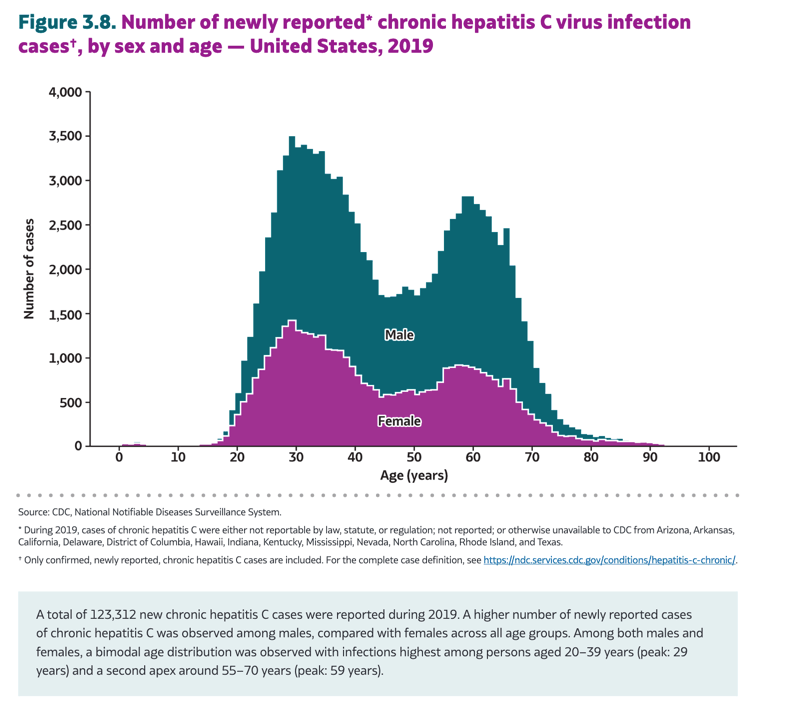
Despite this progress, incident HCV cases continue to increase in the United States. The continued spread of HCV is primarily a consequence of injection drug use; injection-related transmission is now responsible for most new HCV cases. Thus, to reach WHO goals, treating people who inject drugs (PWID) is a priority. Previous studies have identified barriers that PWID face in the HCV care cascade, including low screening rates, low treatment uptake, and ongoing risk of reinfection. Interventions aimed at addressing these issues include improved HCV screening, improvements in keeping patients linked to care, and improved access to harm reduction services, such as syringe service programs (SSPs) and medication-assisted treatment (MAT). These interventions are typically implemented at the state level, and state policies on HCV surveillance, Medicaid reimbursement, and access to harm reduction may affect the success of these efforts. We developed a mathematical model to evaluate improvements to the PWID HCV care cascade (ie, improved testing, improved treatment uptake, and improved access to harm reduction services) and forecast HCV outcomes associated with these interventions. We used New Hampshire as an illustrative setting because it has high rates of injection drug use and, like many states, has underdeveloped infrastructure to track and treat HCV among PWID. Though comprehensive data on PWID HCV testing and treatment in the US is not available, many studies suggest that insufficient rates of testing and treatment are common throughout the US.8,14-16 Recent published editorials from HCV experts describe a paucity of testing and treatment in the US for PWID,17,18 though they do not comment on state-by-state specifics. Taken together, this suggests the low rates of testing and treatment in NH are common in other states as well. New Hampshire (NH) provides an interesting setting for studying HCV elimination among PWID in the United States (US) because of its historically low rates of HCV testing and treatment and its high rates of injection drug use during the opioid crisis. Though the rate of injection drug use in NH is high compared to most other states, the lack of infrastructure for testing, treatment, and harm-reduction services appears to be common throughout the US. There were no legally operating SSPs in NH before 2017.19 Since SSPs were legalized in NH in 2017, there has been continued growth in the number of SSPs and the number of total syringes distributed in NH.11 Overall, the evidence suggests that poor access to SSPs is common in the US. Rates of injection drug use rose substantially in NH during the opioid crisis, with a clear increase in past-year heroin use. Recent work by Romo et al. suggests HCV prevalence among PWID in NH is high though consistent with previous studies in the US.8,9 HCV was not a reportable disease in NH until November 3, 2016, and there is no state-reported HCV prevalence data before then. Moreover, little testing has been done in potentially high-contact settings for PWID such as syringe service programs (SSPs) or medication-assisted treatment (MAT) programs.10,11 Medicaid restrictions on treatment were strict in NH before 2016.
Discussion
We developed a dynamic model to evaluate interventions aimed at specific failures in the HCV care cascade for PWID, ie, insufficient testing, low treatment uptake, and inadequate access to harm reduction, and forecasted HCV outcomes associated with these interventions in New Hampshire. Our results suggest that improvements in both testing and treatment are required to achieve the WHO goal of reducing HCV incidence by 80% among PWID in New Hampshire by 2030. Monte Carlo simulation suggests this conclusion is robust despite parameter uncertainty. However, achieving similar reductions in HCV-related mortality by 2030 is unlikely because of the many PWID who currently have advanced liver disease. If we were to assume that HCV treatments can reverse liver damage in patients with advanced fibrosis, these mortality forecasts might be improved.38
Although other states may experience different bottlenecks than New Hampshire, studies have consistently found insufficient testing and poor rates of treatment after diagnosis among PWID.7-9,21 Thus, similar improvements in testing and treatment may be required to reach elimination targets in other states. Bottlenecks in the HCV care cascade often originate from state-level policies on Medicaid reimbursement and HCV surveillance efforts. Examples of interventions to increase testing and treatment uptake include conducting screening and treatment in prisons; community integration of HCV education, workup, and treatment; and removing Medicaid restrictions on sobriety, prescriber, and fibrosis criteria.11,13,15,39 The lack of good state-level data on PWID poses a challenge for policy makers seeking to identify and address weaknesses in their HCV care cascade; resources like the Hepatitis C Medicaid Affinity Group can help states share best practices.40
Our results also highlight an important role played by harm-reduction programs. In addition to reducing the risk of infection, harm-reduction programs can promote regular testing, facilitate linkage to care, and provide access to active PWID who are not often reached in traditional settings. Despite the well-documented benefits of harm-reduction programs, access to both MAT and SSPs remains limited and varies widely by state.41-44 Our analysis suggests that increases in the availability of harm-reduction services could enhance testing and treatment efforts and may reduce the number of treatments required for HCV elimination.
The cost associated with treatment is likely to be a key concern for state stakeholders, particularly given the high cost of direct-acting antivirals and the high prevalence of HCV among Medicaid beneficiaries.15,45 The scenarios associated with HCV elimination are forecast to require a substantial increase in treatments before 2030 but fewer total treatments over the forecast period. Payment models in which a state pays a subscription fee for unlimited HCV treatments over a fixed period (ie, the Netflix model) may be well suited for the early years of an elimination effort.46
Limitations
There are several limitations to this study. As in other studies of HCV among PWID, the data necessary to parameterize the model are scarce, particularly at the state level. We used New Hampshire-specific data when possible and included wide ranges of uncertainty for parameters in our Monte Carlo simulation analysis. We did not model HCV among other high-risk groups besides PWID, notably baby boomers, incarcerated populations, and men who have sex with men.47 We did not consider the effects of HIV-HCV coinfection, which can result in a more severe disease course.48 In addition, we did not conduct a cost-effectiveness analysis of the interventions considered here; such a study would be useful to better understand the tradeoffs involved.
Conclusions
In this modeling study, no single intervention was projected to achieve World Health Organization HCV elimination targets. However, the findings suggest that coordinated improvements in testing, treatment, and harm-reduction programs could greatly reduce the HCV burden among PWID in New Hampshire and other states facing similar challenges.
The number of cases reported during 2019 corresponded to a 14% increase from the 3,621 cases reported during 2018, and a 133% increase from the 1,778 cases reported during 2019.
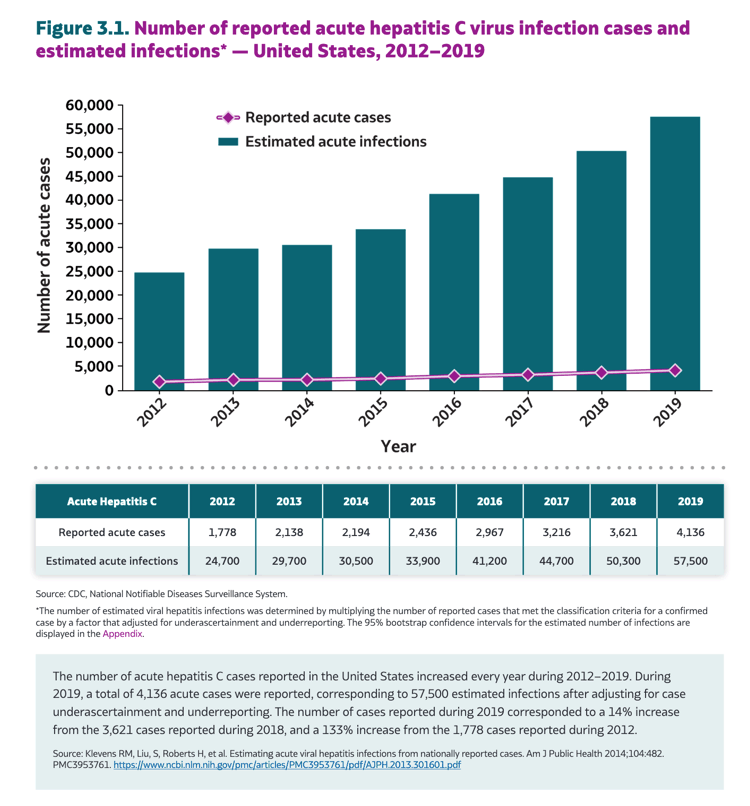
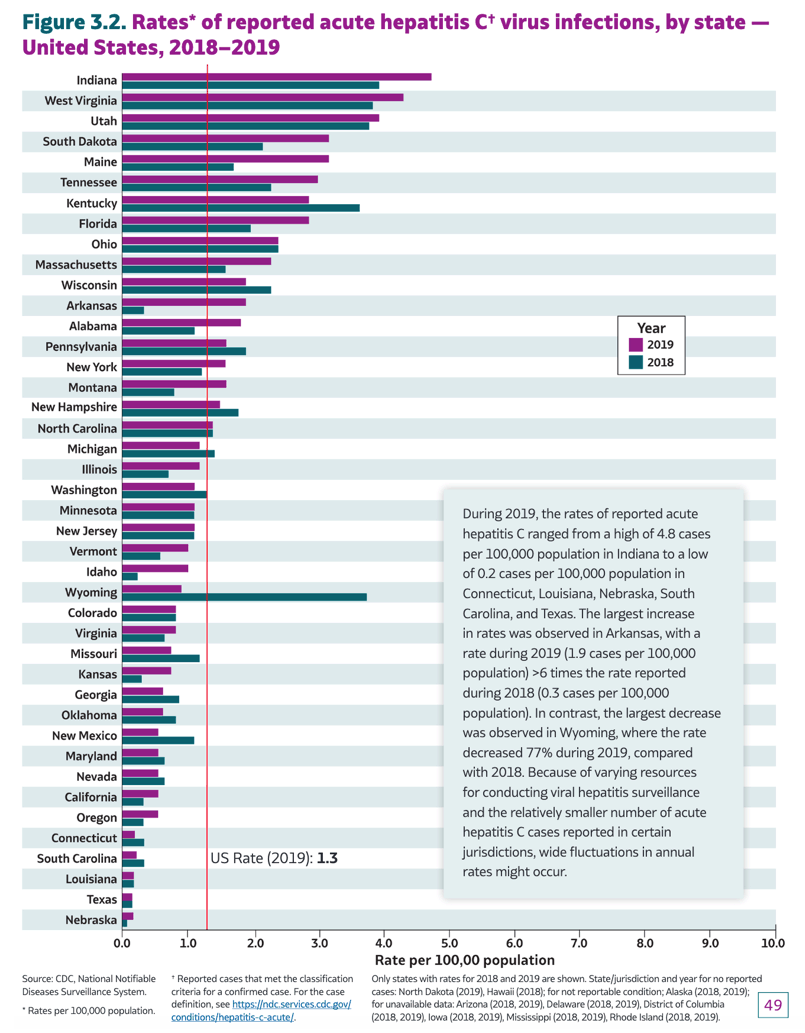
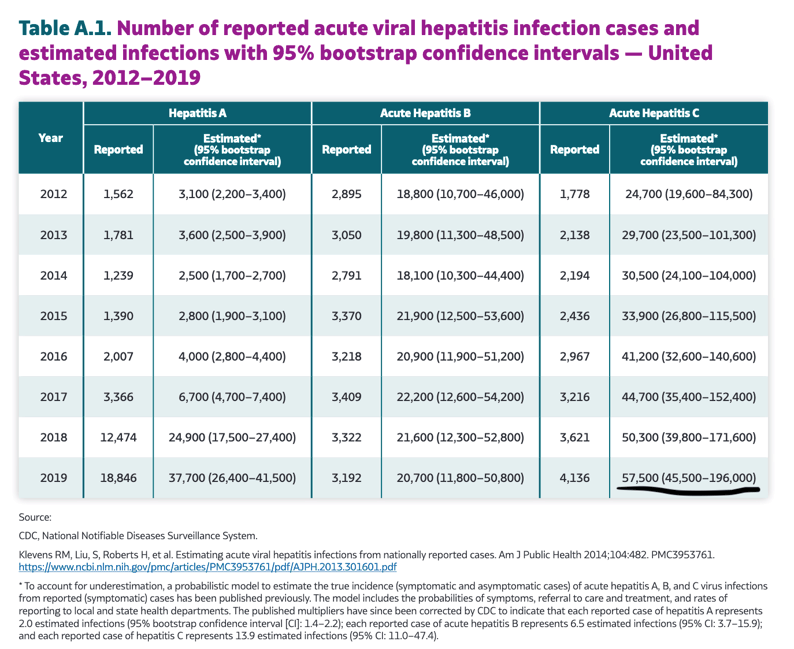
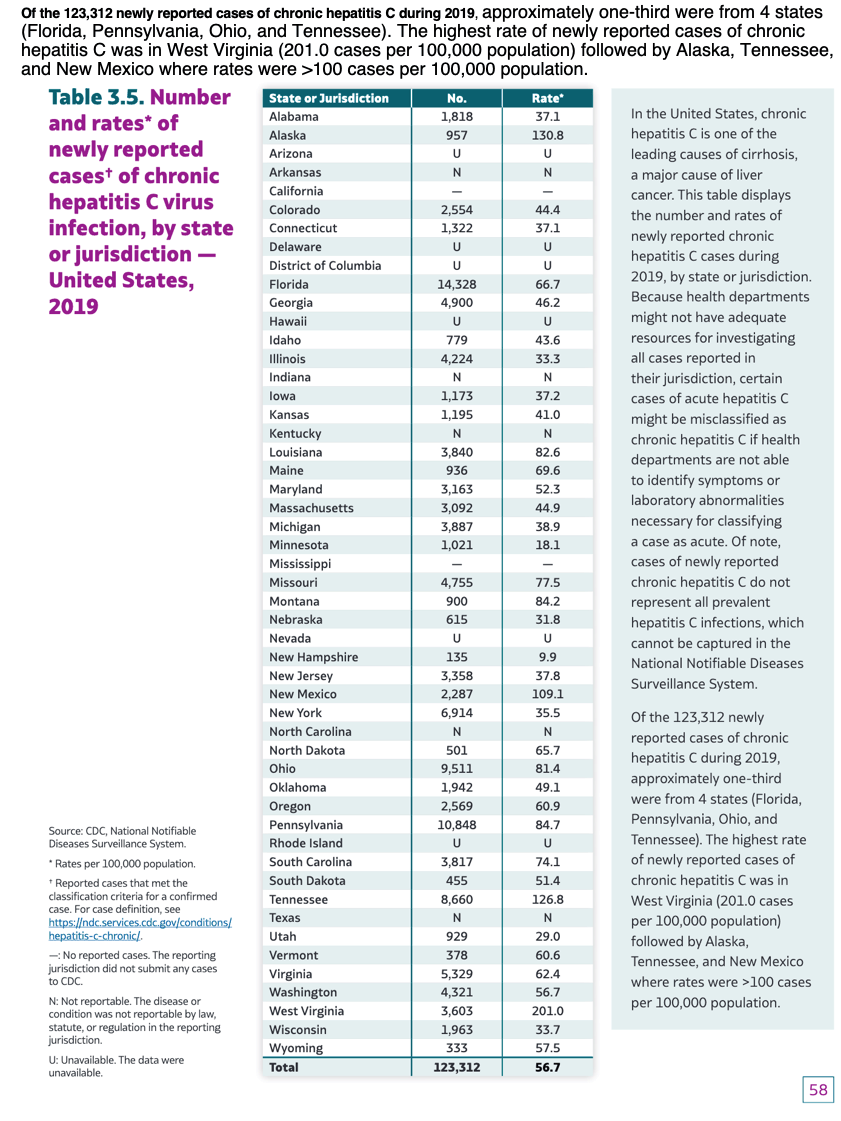
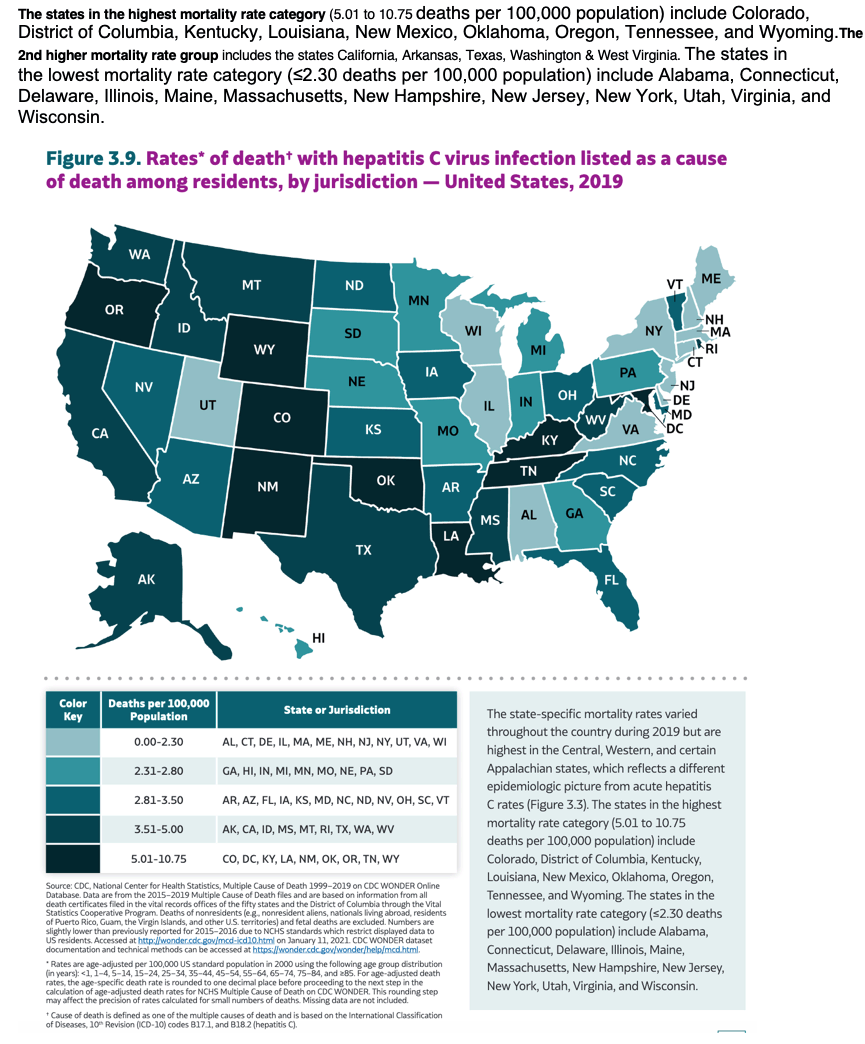
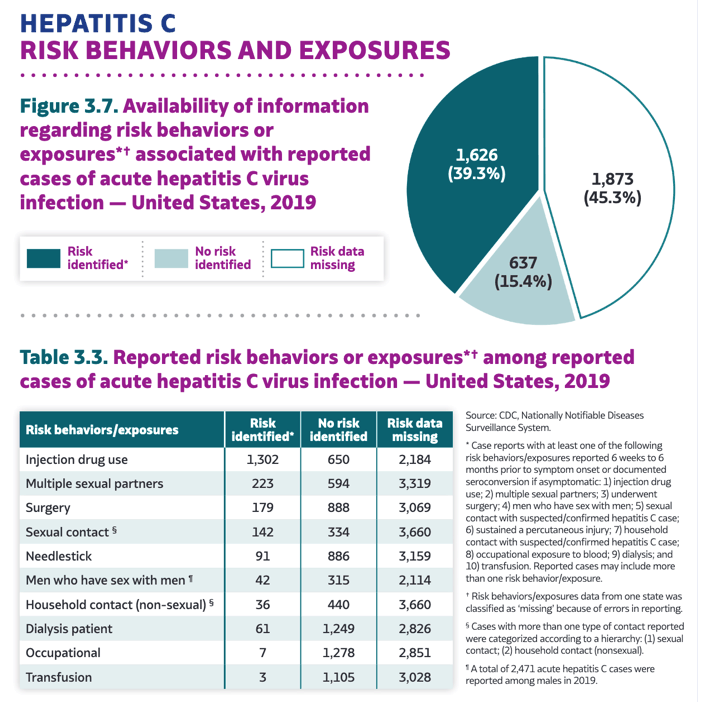
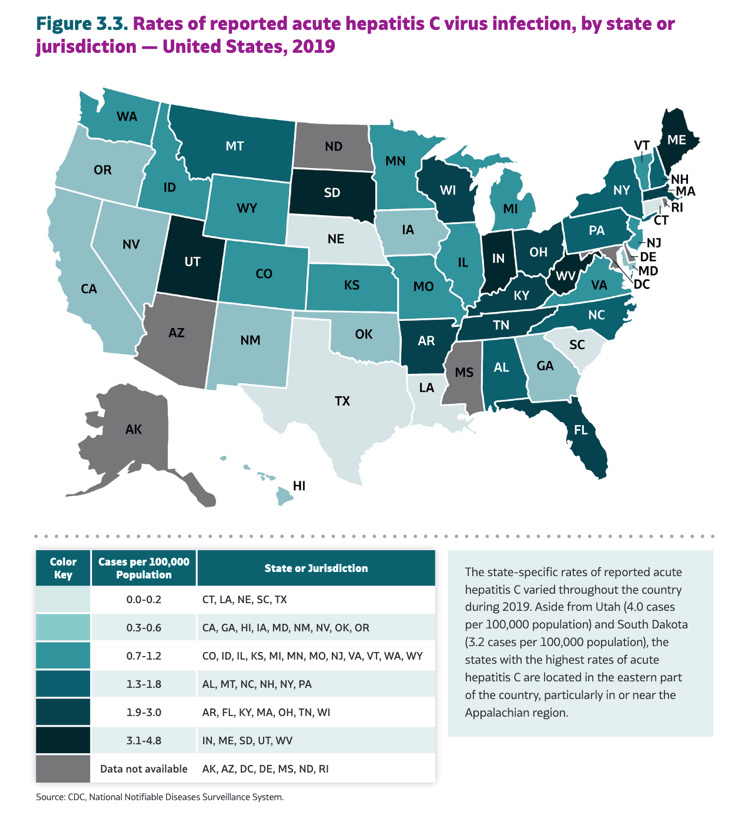
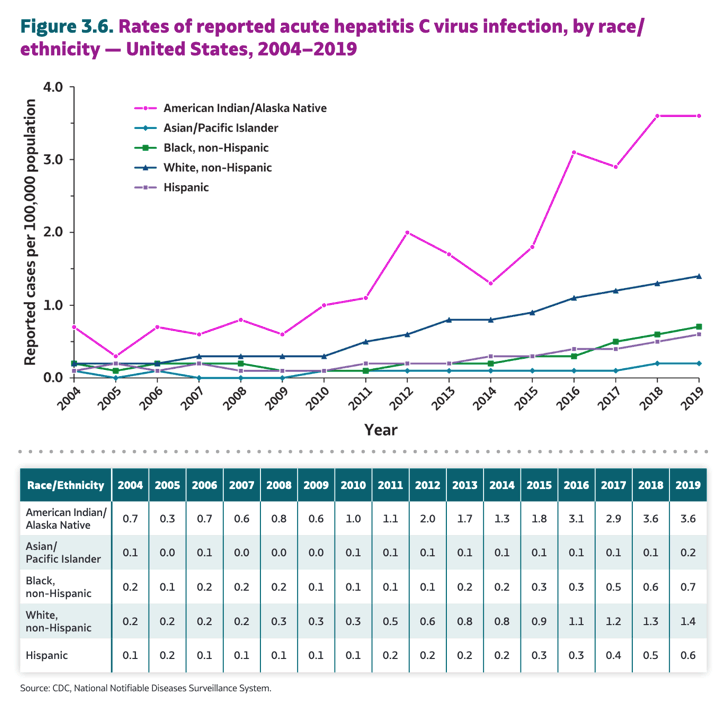
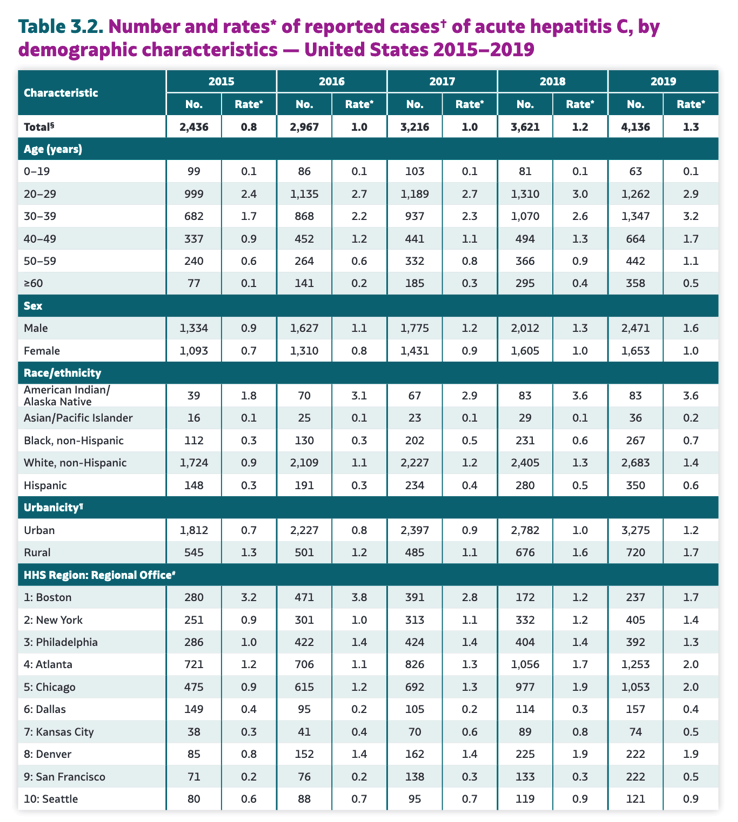
----------------------------------------------
August 3, 2021
Modeling Hepatitis C Elimination Among People Who Inject Drugs in New Hampshire
JAMA Netw Open. 2021
Key Points
Question What improvements in the hepatitis C (HCV) care cascade are required to eliminate HCV among people who inject drugs (PWID)?
Findings This decision analytic model of HCV transmission found that improved testing, treatment, and access to harm reduction were all associated with reductions in HCV prevalence and mortality among PWID. Improvements in both testing and treatment were associated with HCV prevalence of less than 2% by 2030.
Meaning These findings suggest that HCV elimination may be possible among PWID by 2030 with improved testing and treatment; improved harm reduction may reduce the time and number of treatments required to achieve similar outcomes.
Abstract
Importance The success of direct-acting antiviral therapies for chronic hepatitis C virus (HCV) infection led the World Health Organization to set elimination targets by 2030. For the United States to achieve these benchmarks, public health responses must target high-risk populations, such as people who inject drugs (PWID), a group with high rates of HCV incidence and low rates of treatment uptake.
Objective To evaluate potential improvements in the HCV care cascade among PWID, focusing on improved testing, treatment uptake, and access to harm reduction.
Design, Setting, and Participants This decision analytic model used a differential equation-based dynamic transmission model based on data from New Hampshire, an illustrative state with a large number of PWID and limited HCV treatment infrastructure. Surveillance data through 2020 was used for model parameterization, and the final analysis was conducted in May 2021.
Main Outcomes and Measures Model forecasts of chronic HCV cases and advanced-stage HCV outcomes from 2022 to 2045.
Results A total of 6 scenarios were tested: (1) the base case, (2) improved harm reduction, (3) improved testing, (4) improved treatment, (5) improved testing and treatment, and (6) improved testing, treatment, and harm reduction. All scenarios with improved testing, treatment uptake, and/or access to harm reduction were associated with decreases in forecasted HCV prevalence and HCV-associated mortality compared with the base case. Improving harm reduction, testing, and treatment individually were forecast to reduce prevalence of HCV in 2045 from 69.7% in the base case to 62.8%, 45.7%, and 35.5%, respectively. Combining treatment and testing improvements was associated with a 2045 prevalence of 0.3%; adding harm reduction improvements was associated with further reductions in prevalence forecasts (to 0.2%), with fewer total treatments (10 960 vs 13 219 from 2022-2045).
Conclusions and Relevance In this modeling study, no single intervention was projected to achieve World Health Organization HCV elimination targets. Scenarios with improvements in both testing and treatment were associated with a prevalence of less than 3% by 2030 and achieved elimination targets. Adding improvements in harm reduction was associated with faster reductions in prevalence and fewer treatments.
Introduction
An estimated 2.4 million people in the United States live with chronic hepatitis C virus (HCV), and HCV-associated deaths are higher than the next 60 reportable infectious diseases combined.1,2 The development of direct-acting antivirals has dramatically improved our ability to treat HCV, and the World Health Organization (WHO) proposed 2030 HCV elimination targets, including an 80% reduction in new chronic infections and a 65% reduction in mortality from 2015 levels.3
Despite this progress, incident HCV cases continue to increase in the United States.4 The continued spread of HCV is primarily a consequence of injection drug use; injection-related transmission is now responsible for most new HCV cases.5 Thus, to reach WHO goals, treating people who inject drugs (PWID) is a priority.
Previous studies have identified barriers that PWID face in the HCV care cascade, including low screening rates, low treatment uptake, and ongoing risk of reinfection.6-10 Interventions aimed at addressing these issues include improved HCV screening, improvements in keeping patients linked to care, and improved access to harm reduction services, such as syringe service programs (SSPs) and medication-assisted treatment (MAT).11,12 These interventions are typically implemented at the state level, and state policies on HCV surveillance, Medicaid reimbursement, and access to harm reduction may affect the success of these efforts.13-15
We developed a mathematical model to evaluate improvements to the PWID HCV care cascade (ie, improved testing, improved treatment uptake, and improved access to harm reduction services) and forecast HCV outcomes associated with these interventions. We used New Hampshire as an illustrative setting because it has high rates of injection drug use and, like many states, has underdeveloped infrastructure to track and treat HCV among PWID (eAppendix and eFigure 1 in the Supplement).16,17 To our knowledge, previous studies12,18,19 of HCV elimination among PWID have not modeled the full range of interventions considered here.
eAppendix. Supplementary Methods and Results
New Hampshire Context
New Hampshire (NH) provides an interesting setting for studying HCV elimination among PWID in the United States (US) because of its historically low rates of HCV testing and treatment and its high rates of injection drug use during the opioid crisis. Though the rate of injection drug use in NH is high compared to most other states, the lack of infrastructure for testing, treatment, and harm-reduction services appears to be common throughout the US. This section provides some background on the current state of injection drug use, HCV prevalence, HCV testing, HCV treatment, and harm-reduction efforts in NH and, when possible, how NH compares to other states.
Injection Drug Use in New Hampshire
Rates of injection drug use rose substantially in NH during the opioid crisis, with a clear increase in past-year heroin use from 2013-2018 observed in the National Surveys on Drug Use and Health.1 This increased use of injection drug use is reflected in a rapid increase in overdose deaths during this period (eFigures 1a and b). Heroin and fentanyl are now responsible for the majority of drug overdoses in the state2 (eFigure 1b). The majority of overdose deaths, ED visits, and EMS naloxone occur among individuals age 20-49, mirroring national trends in HCV incidence attributable to PWID.3 Rising rates of complications related to injection drug use - such as infective endocarditis or outbreaks of HIV similar to that seen in Scott County, Indiana - have also been noted.4,5
NH has consistently been among states with the highest overdose mortality since 2014.6 A 2017 "hotspot" report prepared by the National Drug Early Warning System studied this issue in some detail, identifying reasons for the rapid growth in overdoses from 2010-2016. Reasons identified include high rates of substance abuse, high historical rates of opioid prescribing, and poor access to substance abuse treatment and harm reduction programs (more below).7
HCV Prevalence, Testing, and Treatment:
Recent work by Romo et al. suggests HCV prevalence among PWID in NH is high though consistent with previous studies in the US.8,9 HCV was not a reportable disease in NH until November 3, 2016, and there is no state-reported HCV prevalence data before then. Moreover, little testing has been done in potentially high-contact settings for PWID such as syringe service programs (SSPs) or medication-assisted treatment (MAT) programs.10,11 Medicaid restrictions on treatment were strict in NH before 2016: patients were required to have F3 or greater liver disease, six months of sobriety and prescribers had to be a specialist or a physician with continuing medical education in HCV treatment.12 These restrictions were relaxed in 2016, but prescribers must still document addiction treatment and periodic screens for alcohol use.12 Such restrictions have limited HCV testing and treatment in NH and impeded HCV elimination efforts.8,13
Though comprehensive data on PWID HCV testing and treatment in the US is not available, many studies suggest that insufficient rates of testing and treatment are common throughout the US.8,14-16 Recent published editorials from HCV experts describe a paucity of testing and treatment in the US for PWID,17,18 though they do not comment on state-by-state specifics. Taken together, this suggests the low rates of testing and treatment in NH are common in other states as well.
Harm-reduction
There were no legally operating SSPs in NH before 2017.19 Since SSPs were legalized in NH in 2017, there has been continued growth in the number of SSPs and the number of total syringes distributed in NH.11 Previous studies demonstrate significant heterogeneity state-by-state in SSP coverage, leaving many PWID with insufficient access to clean needles.20,21 Access to SSPs has grown during the opioid crisis - in NH and across the country - but legal barriers remain in many places. Overall, the evidence suggests that poor access to SSPs is common in the US.
As in many states, the capacity for treatment in MAT was far below the estimated prevalence of opioid use disorder at the beginning of the opioid crisis.22 The 2017 "hotspot" report described above notes that NH has historically had low funding for public health, low rates of substance abuse treatment, and few buprenorphine-waivered prescribers.7In response to the opioid crisis, state leaders have dedicated millions of dollars to expanding treatment options in NH. Data from the National Survey of Substance Abuse Treatment Services show substantial growth in the number of MAT facilities and MAT participation in NH and across the country from 2013-2019.10,23
| |
| |
| |
|
|
|